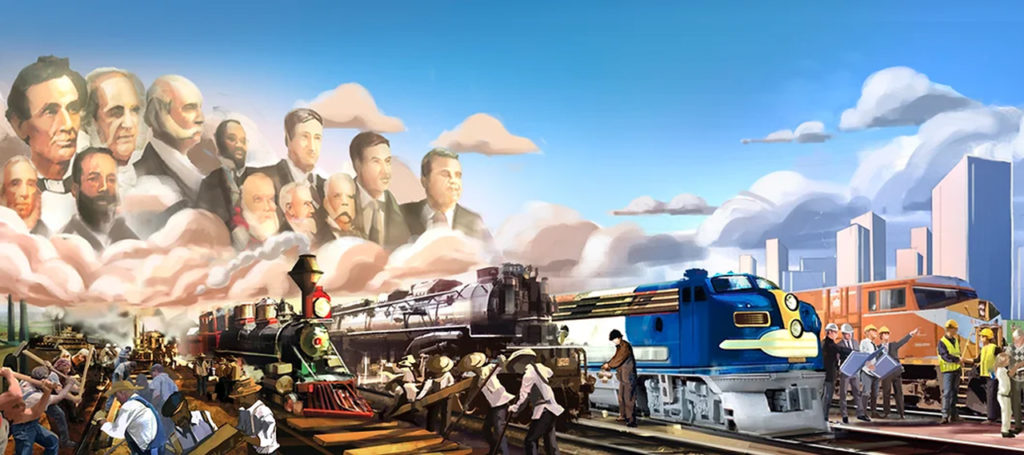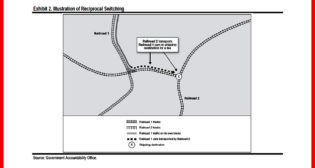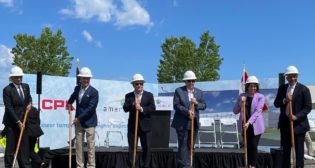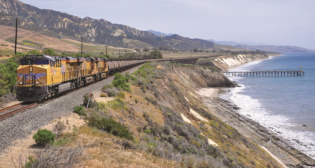
Gaskins, Hagen, Krebs Inducted into NRRHF
Written by William C. Vantuono, Editor-in-Chief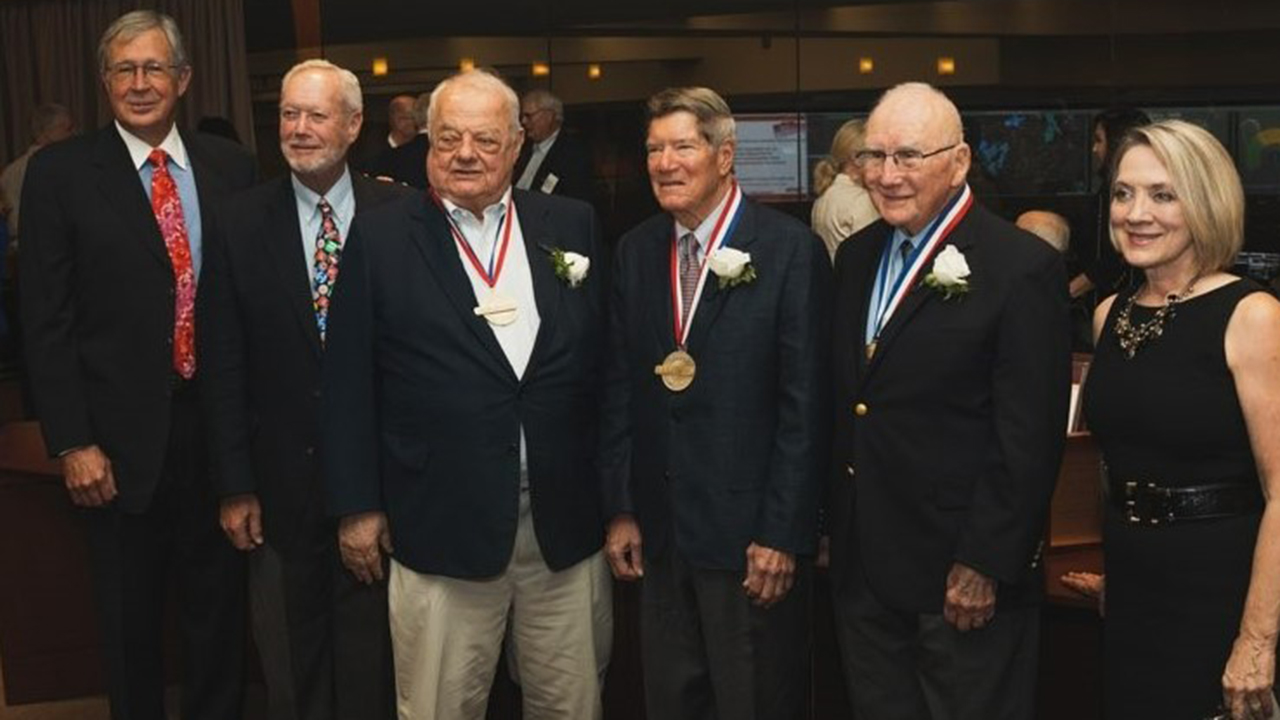
Left to right: National Railroad Hall of Fame Rail Industry Advisory Group Chair Brooks Bentz, NRRHF Founder Bob Bondi, Darius Gaskins, Rob Krebs, Jim Hagen and NRRHF Executive Director Julie King
Three iconic rail industry veterans—Darius W. Gaskins, Jr., Robert D. Krebs and James A. Hagen—were inducted into the National Railroad Hall of Fame (NRRHF) in a Nov. 8 ceremony at BNSF Railway headquarters in Fort Worth, Tex. The organization inducts rail industry people annually based on its Rail Industry Advisory Group recommendations.
Gaskins, former President and CEO of Burlington Northern Railway and Railway Age’s 1988 Railroader of the Year; Hagen, former Chairman, President and CEO of Conrail and USRA President; and Krebs, former BNSF President and CEO, Atchison, Topeka & Santa Fe CEO, Southern Pacific CEO, and Railway Age’s 1996 Co-Railroader of the Year with BN’s Gerald Grinstein, “led railroads out of a period of decline in the 1960s and 1970s into a rail renaissance that followed partial industry deregulation in 1980,” said NRRHF Rail Industry Advisory Group Chair Brooks Bentz. “The rail network that serves our country today was shaped as a direct result of their work.”
BNSF President and CEO Katie Farmer offered closing remarks at the ceremony and sponsored a reception for guests in BNSF headquarters Visitors’ Gallery.
Darius W. Gaskins, Jr.
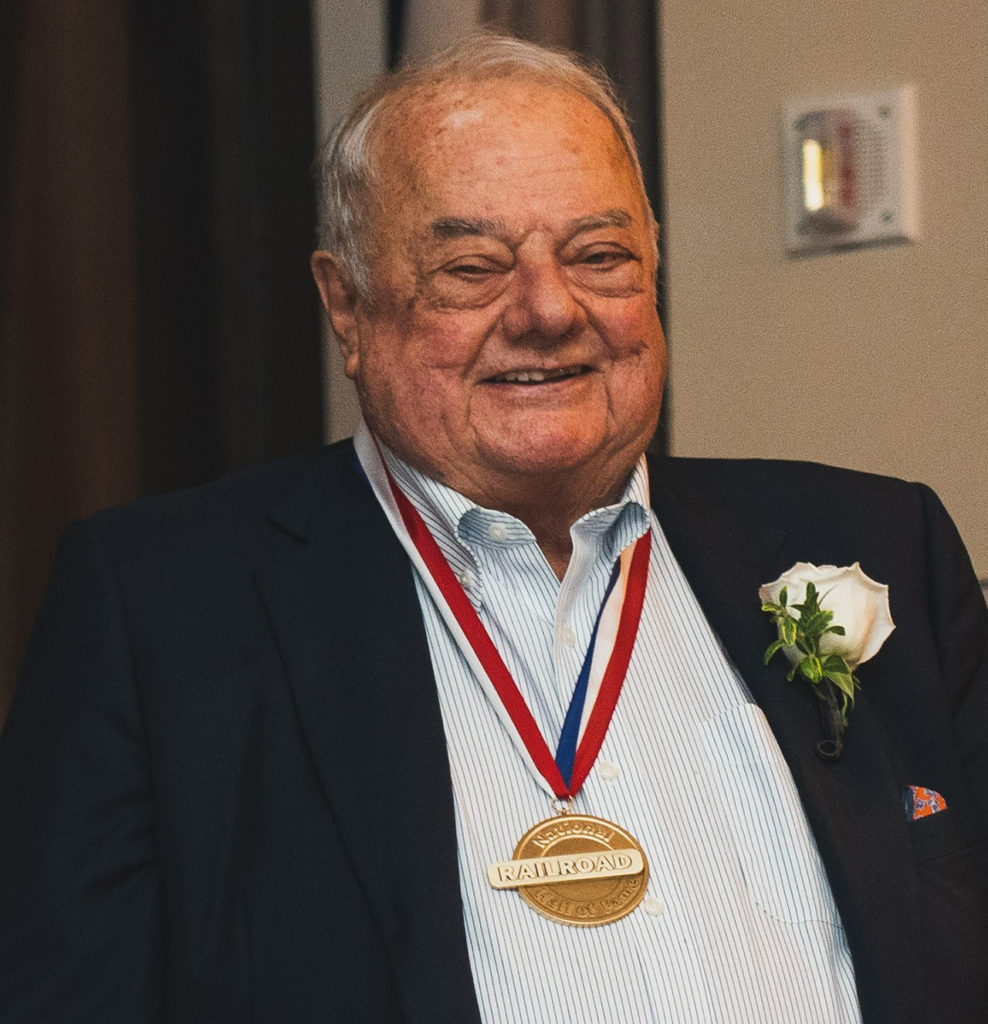
Gaskins was born Sept.16, 1939, in Washington, D.C. He graduated from Sidwell Friends School and earned a Bachelor of Science from West Point Military Academy in 1961. He earned an MSE in Aerospace Engineering and an MSE in Instrumentation Engineering from the University of Michigan in 1963. From 1963 to 1967, Gaskins served as a Captain in the U.S. Air Force, working as an instructor at the Aerospace Research Pilots School. In 1967, he returned to the University of Michigan, where he graduated with a Ph.D in Economics in 1970.
Gaskins taught economics as an Assistant Professor at UC-Berkeley from 1970 to 1973. He then returned to the East Coast, where he directed economic analysis for the U.S. Department of Interior offices of Minerals and Outer Continental Shelf, as well as for the U.S. House of Representatives’ Ad Hoc Committee on the Outer Continental Shelf. Gaskins briefly returned to UC-Berkeley before accepting an assignment at the Federal Trade Commission as Director of the Bureau of Economics. He transitioned to the Civil Aeronautics Board as Director of the Office of Economic Analysis, and in 1978, joined the newly created Department of Energy as Deputy Assistant Secretary for Policy Analysis.
In 1979, President Jimmy Carter nominated Gaskins to the Interstate Commerce Commission (ICC) and named him ICC Chairman later that year. The Staggers Rail Act took effect in October 1980, partially deregulating the railroad industry. “As ICC Chairman, Gaskins helped save the beleaguered industry by easing regulatory restrictions, allowing rates to rise where needed, and permitting abandonment of lines and markets that were unprofitable,” NRRHF noted. “The result was an American rail renaissance.”
Gaskins resigned his ICC post in February 1981 at the start of the Reagan Administration. The following year, he joined Burlington Northern as Senior VP for Marketing and Sales. In July 1985, Gaskins was promoted to President and COO, and by December 1985, he was named BN’s President and CEO.
“Under Gaskins’ leadership, BN was the first in the industry to organize its marketing department into business units,” NRRHF said. “The company consolidated hundreds of country piggyback ramps down to 22 strategic intermodal hub centers, enabling dedicated and scheduled intermodal trains to compete with all-highway moves. Certificates of Transportation were created to put BN grain pricing in sync with seasonal demand, and pricing incentives were offered to grain companies that shipped commodities in shuttle trains. Gaskins resigned his post in April 1989, having fostered a climate of creativity and innovation that successfully led the company into the post-Staggers, free-market era.”
James A. Hagen
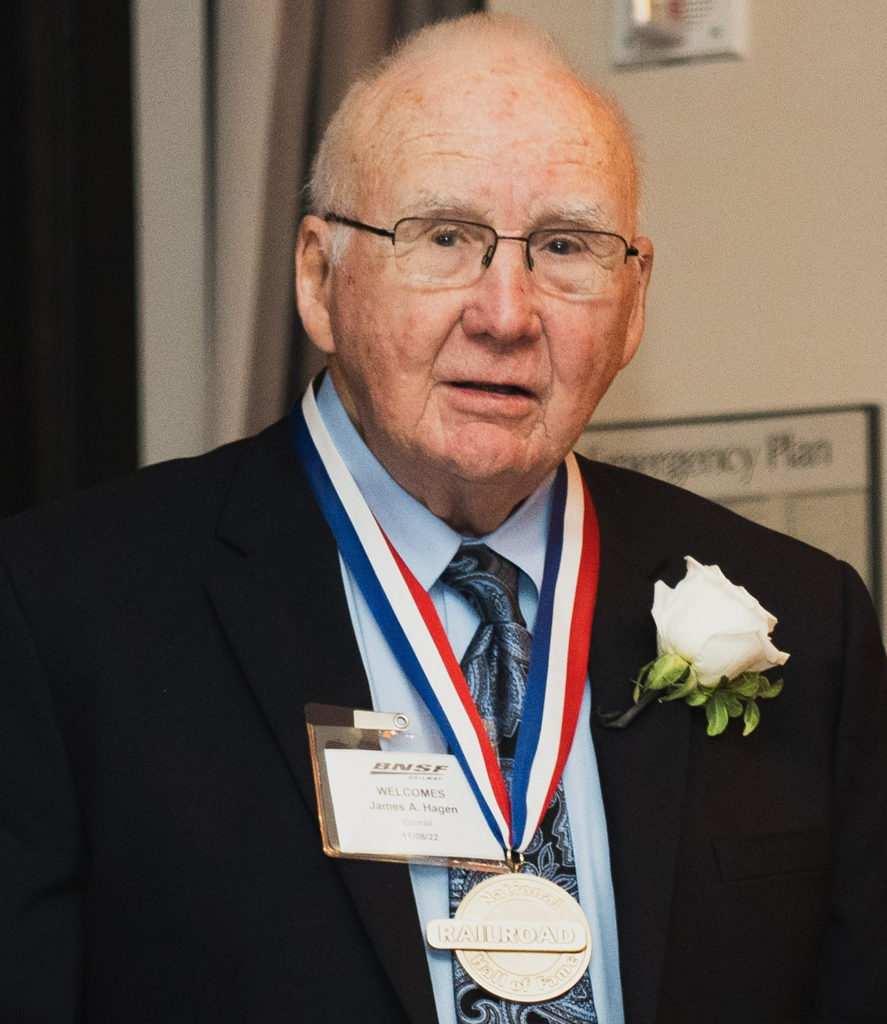
Hagen was born in Forest City, Iowa, on March 27, 1932. He enrolled in St. Ambrose University in Davenport, Iowa, but his undergraduate studies were interrupted in 1953 when he was drafted into the U.S. Army. He returned to complete his degree in Economics and went on to earn a graduate degree in Business from the University of Iowa.
In 1958, Hagen joined the Missouri Pacific, conducting research and analysis in the pricing department. He attended night school to study ICC law and became an ICC Practitioner. In 1963, he moved to Washington, D.C., where he analyzed markets for the Southern Railway. He transitioned to the Federal Railroad Administration to oversee policy and planning in 1972.
Hagen arrived at FRA amidst an economic crisis in the rail industry that had plunged six northeastern Class I carriers—Penn Central, Erie-Lackawanna, Reading. Jersey Central, Lehigh Valley, Lehigh & Hudson River—into bankruptcy. In response, Congress created the U.S. Railway Association (USRA) to develop a plan to rescue the Northeast’s failing rail system. Hagen was appointed Vice President of Operations & Planning at USRA, and in July 1975 became the association’s President.
Hagen and his team set about the monumental task of restructuring the Northeast railroad system. They identified more than 15,500 miles of excess trackage between St. Louis and the Atlantic coast. What remained—nearly 25% of the region’s railroads—were merged to form the Consolidated Railroad Corporation, or Conrail. Conrail began operations on April 1, 1976, taking over virtually all operations in the Northeast.
Hagen left USRA in May 1976 to become a corporate planner at the Southern Railway. In 1977, he joined Conrail as Senior Vice President of Marketing and Sales. “Hagen understood that Conrail’s profitability was stymied by government regulation,” NRRHF noted. “He lobbied for passage of the Staggers Rail Act, which became effective in October 1980. Its enactment marked the beginning of Conrail’s recovery. Hagen’s marketing skills impressed CSX, which hired him in March 1985 as Executive Vice President of its Baltimore-based marketing arm, CSX Distribution Services. He returned to Conrail in May 1989 to become the line’s third Chairman, President CEO. With his collegial management style, Hagen set about changing Conrail’s culture to spark creativity and collaboration. Hagen retired on May 15, 1996, having successfully reorganized the northeastern railroad system, which helped stem an industry-wide crisis and prevent a federal takeover.”
Robert D. Krebs
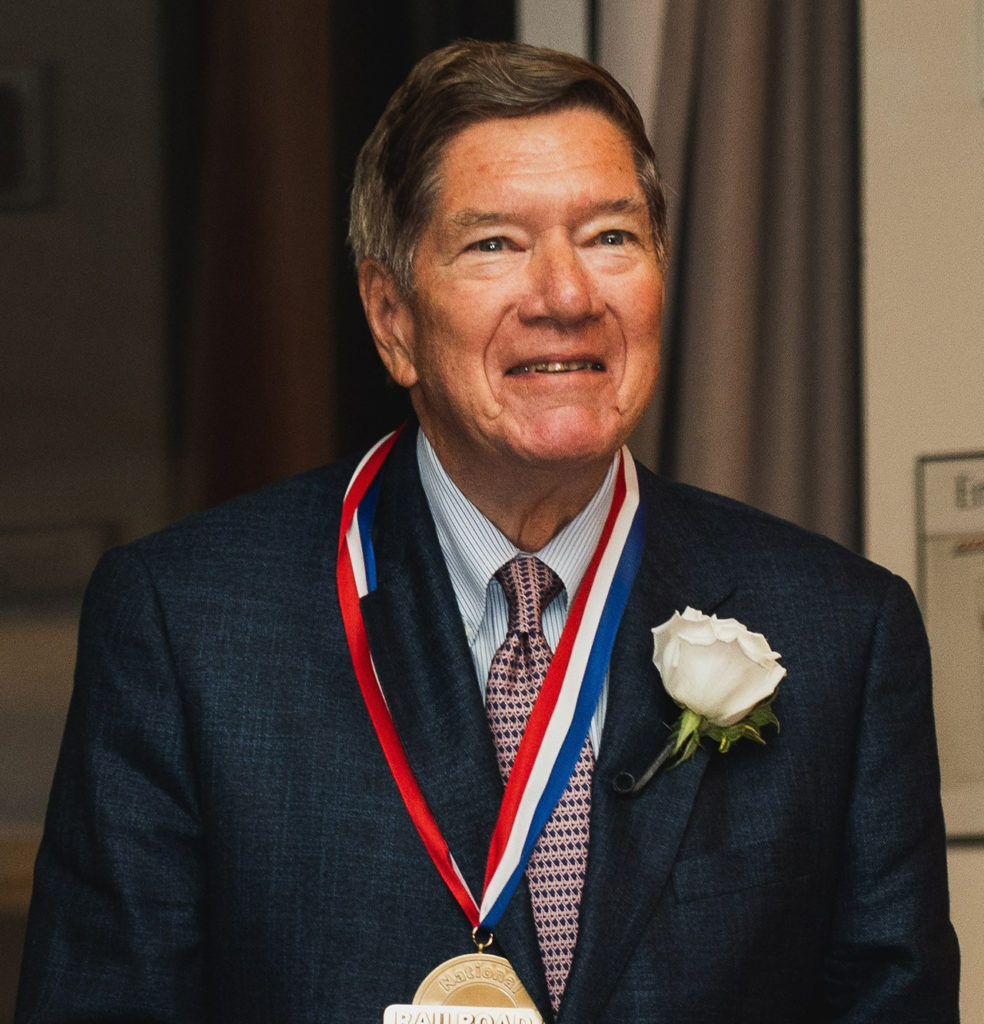
Krebs was born in Sacramento, Calif, on May 2, 1942. He earned a bachelor’s degree in political science from Stanford in 1964 and an MBA from Harvard Business School in 1966 before entering the Southern Pacific management training program. After Krebs completed the trainee program, he asked to attend the IBM computer school to learn coding for SP’s Total Operations Processing System. On the advice of a superior, he soon transferred to operations. “The folks who will run the railroad will not sit behind computer terminals, he was told, so he sought a challenging field position instead” NRRHF noted
Krebs advanced steadily through SP’s ranks, and in July 1982 was named President of Southern Pacific Transportation Company. The SP Board determined that SP would not remain viable without a partner, and SP pursued a merger with the Santa Fe. The merger of the SP and Santa Fe holding companies took place at the end of 1983, and Krebs was named President and Chief Operating Officer of the newly formed Santa Fe Southern Pacific Corporation (SFSP), with headquarters in Chicago. In 1986, the ICC rejected the merger of the two railroads and ordered SFSP to sell one or both. Shortly thereafter, Krebs became SFSP CEO, and he and the company’s Board opted to sell the Southern Pacific to Phil Anschutz.
In January 1986, SFSP announced a major restructuring that included selling or spinning off most of its non-rail assets, and Krebs took over as CEO of Santa Fe. He trimmed Santa Fe’s route-miles and headcount, taking full advantage of the railroad’s Los Angeles to Chicago “Transcon” line to build intermodal service. Fueled by partnerships with J.B. Hunt, UPS at Willow Springs in Chicago, and the Perot family in Alliance, Texas, Santa Fe’s operating income nearly tripled between 1990 and 1994.
“Despite the improvements, Krebs knew the Santa Fe was not big enough to survive in the long term,” NRRHF said. “Recognizing that a merger with Burlington Northern would offer synergies in route structure and commodity mix, he initiated merger talks in 1993. The Burlington Northern-Santa Fe merger was completed on Sept. 22, 1995. As BNSF President and CEO, Krebs oversaw the challenges of merging a high-speed intermodal line with a heavy-tonnage carrier. His personal growth as a leader guided his management team in forging a common vision for the company. Within five years, freight tonnage and revenue rose 20% despite average rate declines of 11%. On-time deliveries reached 91%, and profits increased by 16% annually. Krebs retired in May 2001, having led three Class I railroads, and having overseen creation of the largest rail network in North America at the time.”
